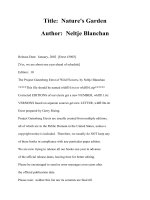Nature''s templates - identifying the patterns that control events
Bạn đang xem bản rút gọn của tài liệu. Xem và tải ngay bản đầy đủ của tài liệu tại đây (428.99 KB, 21 trang )
17. září 2004
80 ze 412
6
NATURE'S
TEMPLATES:
IDENTIFYING THE
PATTERNS THAT
CONTROL EVENTS
ome years ago, I witnessed a tragic accident while on an early spring
canoe trip in Maine. We had come to a small dam, and put in to
shore to portage around the obstacle. A second group arrived, and
a young man who had been drinking decided to take his rubber raft
over the dam. When the raft overturned after going over the dam, he
was dumped into the freezing water. Unable to reach him, we
watched in horror as he struggled desperately to swim downstream
against the backwash at the base of the dam. His struggle lasted only a
few minutes; then he died of hypothermia. Immediately, his limp body
was sucked down into the swirling water. Seconds later, it popped up,
ten yards downstream, free of the maelstrom at the base of the dam.
What he had tried in vain to achieve in the last moments of his life, the
currents accomplished for him within seconds after his death.
Ironically, it was his very struggle against the forces at the base of the
dam that killed him. He didn't know that the only way out was
"counterintuitive. If he hadn't tried to keep his head above water,
but instead dived down to where the current flowed downstream, he
would have survived.
S
17. září 2004
81 ze 412
This tragic story illustrates the essence of the systems perspective,
first shown in the beer game in Chapter 3, and again in the arms race at
the beginning of Chapter 5. Structures of which we are unaware hold us
prisoner. Conversely, learning to see the structures within which we
operate begins a process of freeing ourselves from previously unseen
forces and ultimately mastering the ability to work with them and
change them.
One of the most important, and potentially most empowering, in-
sights to come from the young field of systems thinking is that certain
patterns of structure recur again and again. These "systems arche-
types" or "generic structures" embody the key to learning to see
structures in our personal and organizational Jives. The systems ar-
chetypes—of which there are only a relatively small number'—suggest
that not all management problems are unique, something that
experienced managers know intuitively.
If reinforcing and balancing feedback and delays are like the nouns
and verbs of systems thinking, then the systems archetypes are anal-
ogous to basic sentences or simple stories that get retold again and
again. Just as in literature there are common themes and recurring
plot lines that get recast with different characters and settings, a
relatively small number of these archetypes are common to a very
large variety of management situations.
The systems archetypes reveal an elegant simplicity underlying the
complexity of management issues. As we learn to recognize more and
more of these archetypes, it becomes possible to see more and more
places where there is leverage in facing difficult challenges, and to
explain these opportunities to others.
As we learn more about the systems archetypes, they will no
doubt contribute toward one of our most vexing problems, a problem
against which managers and leaders struggle incessantly—speciali-
zation and the fractionation of knowledge. In many ways, the greatest
promise of the systems perspective is the unification of
knowledge across all fields—for these same archetypes recur in bi-
ology, psychology, and family therapy; in economics, political science,
and ecology; as well as in management.
2
Because they are subtle, when the archetypes arise in a family, an
ecosystem, a news story, or a corporation, you often don't see them so
much as feel them. Sometimes they produce a sense of dejd vu, a hunch
that you've seen this pattern of forces before. "There it is again," you
say to yourself. Though experienced managers already know many of
these recurring plot lines intuitively, they often don't
17. září 2004
82 ze 412
know how to explain them. The systems archetypes provide that
language. They can make explicit much of what otherwise is simply
"management judgment.''
Mastering the systems archetypes starts an organization on the
path of putting the systems perspective into practice. It is not enough
to espouse systems thinking, to say, "We must look at the big picture
and take the long-term view." It is not enough to appreciate basic
systems principles, as expressed in the laws of the fifth discipline
(Chapter 4) or as revealed in simulations such as the beer game
(Chapter 3). It is not even enough to see a particular structure under-
lying a particular problem (perhaps with the help of a consultant).
This
can lead to solving a problem, but it will not change the thinking
that
produced
the problem in the first place. For learning organizations, only when
managers start thinking in terms of the systems archetypes, does
systems thinking become an active daily agent, continually revealing
how we create our reality.
The purpose of the systems archetypes is to recondition our per-
ceptions, so as to be more able to see structures at play, and to see the
leverage in those structures. Once a systems archetype is identified, it
will always suggest areas of high- and low-leverage change. Presently,
researchers have identified about a dozen systems archetypes, nine of
which are presented and used in this book (Appendix 2 contains a
summary of the archetypes used here). All of the archetypes are made
up of the systems building blocks: reinforcing processes, balancing
processes, and delays. Below are two that recur frequently, and which
are steppingstones to understanding other archetypes and more
complex situations.
ARCHETYPE 1: LIMITS TO GROWTH
DEFINITION
A reinforcing (amplifying) process is set in motion to produce a
desired result. It creates a spiral of success but also creates inadvertent
secondary effects (manifested in a balancing process) which eventually
slow down the success.
MANAGEMENT PRINCIPLE Don't
push growth; remove the factors limiting growth.
17. září 2004
83 ze 412
WHERE IT IS FOUND
The limits to growth structure is useful for understanding all situa-
tions where growth bumps up against limits. For example, organiza-
tions grow for a while, but then stop growing. Working groups get
better for a while, but stop getting better. Individuals improve them-
selves for a period of time, then plateau.
Many sudden but well-intentioned efforts for improvement bump
up against limits to growth. A farmer increases his yield by adding
fertilizer, until the crop grows larger than the rainfall of the region can
sustain. A crash diet works at first to shave off a few pounds of fat,
but then the dieter loses his or her resolve. We might "solve" sudden
deadline pressures by working longer hours; eventually, however, the
added stress and fatigue slow down our work speed and quality,
compensating for the longer hours.
People who try to break a bad habit such as criticizing others
frequently come up against limits to growth. At first, their efforts to
stop criticizing pay off. They criticize less. The people around them
feel more supported. The others reciprocate with positive feelings,
which makes the person feel better and criticize less. This is a rein-
forcing spiral of improved behavior, positive feelings, and further
improvement. But, then, their resolve weakens. Perhaps they
start to find themselves facing the aspects in others' behavior that
really gives them the most trouble: it was easy to overlook a few little
things, but this is another matter. Perhaps, they just become
complacent and stop paying as close attention to their knee-jerk
criticisms. For whatever reason, before long, they are back to their old
habits.
Once, in one of our seminars, a participant said, "Why, that's just
like falling in love." Cautiously, I asked, "How so?" She re-
sponded, "Well, first, you meet. You spend a little time together and it's
wonderful. So you spend more time together. And it's more
wonderful. Before long, you're spending all your free time together.
Then you get to know each other better. He doesn't always open the
door for you, or isn't willing to give up bowling with his buddies—
every other night. He discovers that you have a jealous streak, or a bad
temper, or aren't very neat. Whatever it is, you start to see each
other's shortcomings." As you learn each other's flaws, she re-
minded the rest of us, the dramatic growth in feelings comes to a
sudden halt—and may even reverse itself, so that you feel worse
about each other than you did when you first met.
17. září 2004
84 ze 412
STRUCTURE
In each case of limits to growth, there is a reinforcing (amplifying)
process of growth or improvement that operates on its own for a
period of time. Then it runs up against a balancing (or stabilizing)
process, which operates to limit the growth. When that happens, the
rate of improvement slows down, or even comes to a standstill.
UNDERSTANDING AND USING THE STRUCTURE
Limits to growth structures operate in organizations at many levels.
For example, a high-tech organization grows rapidly because of its
ability to introduce new products. As new products grow, revenues
grow, the R&D budget grows, and the engineering and research staff
grows. Eventually, this burgeoning technical staff becomes increasingly
complex and difficult to manage. The management burden often
falls on senior engineers, who in turn have less time to spend on
engineering. Diverting the most experienced engineers from en-
gineering to management results in longer product development
times, which slow down the introduction of new products.
3
17. září 2004
85 ze 412
To read any "limits to growth" structure diagram, for example,
start with the reinforcing circle of growth. That circle provides the
structure with its initial momentum. Walk yourself around the circle:
remind yourself how new product growth might generate revenues,
which in turn can be reinvested to generate more new products. At
some point, however, the forces will shift—here, for example, the
growth in R&D budget eventually leads to complexity beyond the
senior engineers' ability to manage without diverting precious time
from product development. After a delay (whose length depends on
the rate of growth, complexity of products, and engineers' man-
agement skills), new product introductions slow, slowing overall
growth.
Another example of limits to growth occurs when a professional
organization, such as a law firm or consultancy, grows very rapidly
when it is small, providing outstanding promotion opportunities. Mo-
rale grows and talented junior members are highly motivated, ex-
pecting to become partners within ten years. But as the firm gets
larger, its growth slows. Perhaps it starts to saturate its market
niche. Or it might reach a size where the founding partners are no
longer interested in sustaining rapid growth. However the growth
rate slows, this means less promotion opportunities, more in-fighting
among junior members, and an overall decline in morale. The limits to
growth structure can be diagrammed as follows:
4
PATTERN OF BEHAVIOR
In each of these structures, the limit gradually becomes more pow-
erful. After its initial boom, the growth mysteriously levels off. The
technology company may never recapture its capabilities for devel-
oping breakthrough new products or generating rapid growth.
17. září 2004
86 ze 412
Eventually, growth may slow so much that the reinforcing spiral
may turn around and run in reverse. The law firm or consulting firm
loses its dominance in its market niche. Before long, morale in the
firm has actually started on a downward spiral, caused by the rein-
forcing circle running in reverse.
Limits to growth structures often frustrate organizational changes
that seem to be gaining ground at first, then run out of steam. For
example, many initial attempts to establish "quality circles" fail ul-
timately in U.S. firms, despite making some initial progress. Quality
circle activity begins to lead to more open communication and col-
laborative problem solving, which builds enthusiasm for more quality
circle activity. But the more successful the quality circles become,
the more threatening they become to the traditional distribution of
political power in the firm. Union leaders begin to fear that the new
openness will break down traditional adversarial relations between
workers and management, thereby undermining union leaders' ability to
influence workers. They begin to undermine the quality
circle activity by playing on workers' apprehensions about being
manipulated and "snowed" by managers: "Be careful; if you keep
coming up with cost saving improvements on the production line,
your job will be the next to go."
5
Managers, on the other hand, are often unprepared to share con-
trol with workers whom they have mistrusted in the past. They end
17. září 2004
87 ze 412
up participating in quality circle activities but only going through the
motions. They graciously acknowledge workers' suggestions but fail to
implement them.
Rather than achieving steady acceptance, quality circle activity rises
for a time—then plateaus or declines. Often, the response of the
leader to disappointing results from the quality circle simply feeds
fuel to the flame. The more aggressively the leader promotes the
quality circle, the more people feel threatened and the more
stonewalling takes place.
You see similar dynamics with "Just in Time" inventory systems,
which depend on new relationships of trust between suppliers and
manufacturers. Initial improvements in production flexibility and
cost are not sustained. Often, the supplier in a JIT system eventually
demands to be a sole source to offset the risk in supplying the man-
ufacturer overnight. This threatens the manufacturer, who is used to
placing multiple orders with different suppliers to guarantee control of
parts supply. The manufacturer's commitment to JIT then wavers.
The supplier's commitment to JIT can likewise waver, once he
realizes that the manufacturer demands to be his prime customer.
Used to having multiple customers, the supplier can't help but wonder
whether the manufacturer will go on ordering parts from multiple









